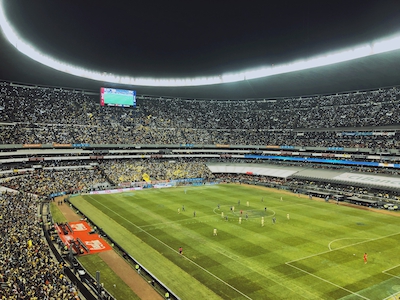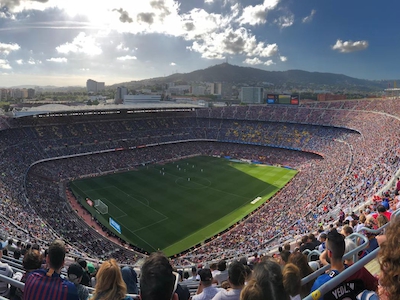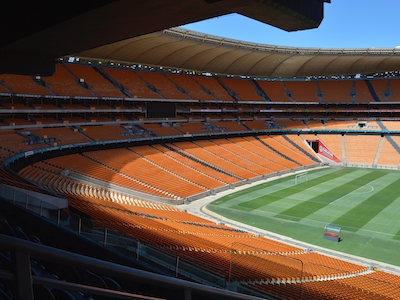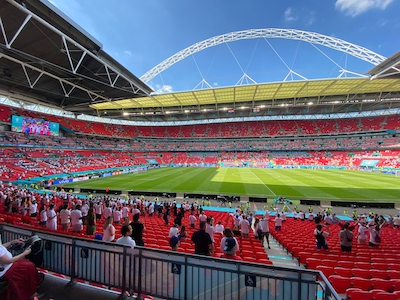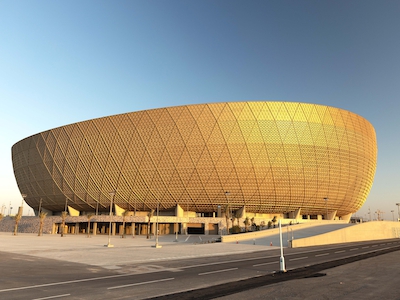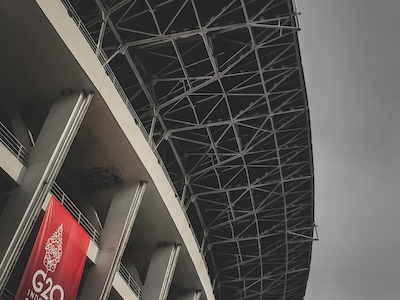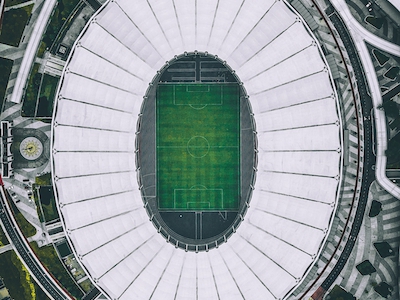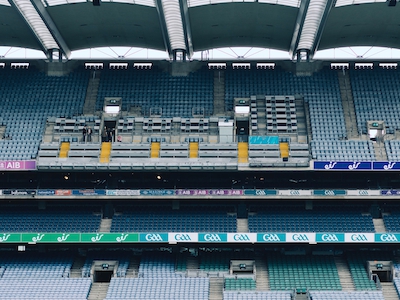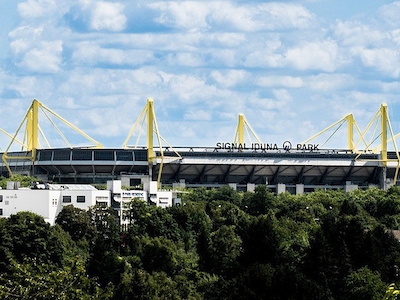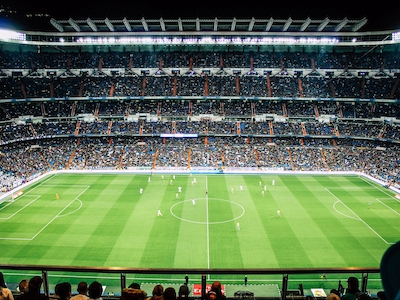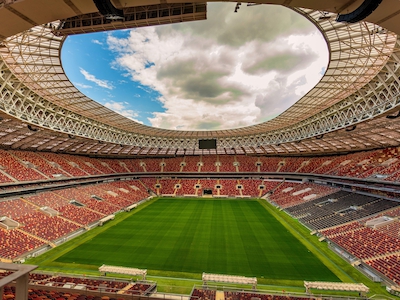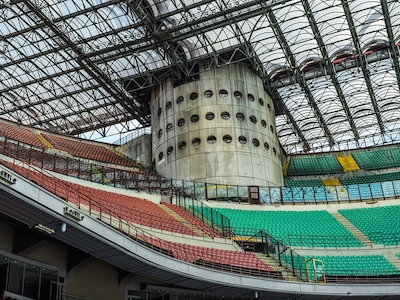The 20 largest stadiums in the world
Worldwide, there are only three stadiums that have space for more than 100,000 spectators. Remarkably, all three stadiums are located outside of Europe. The largest stadium in Europe is FC Barcelona’s home ground: Spotify Camp Nou. A little less than 100,000 people fit in this stadium. The second largest stadium in Europe is Wembley with a capacity of 90,000. Continue reading and discover the 20 largest football stadiums in the world.
1. Rungrado 1st of May Stadium, North Korea - Capacity: 150,000
North Korea of all places – one of the last communist states on earth – possesses an enormous stadium. In fact, Rungrado 1st of May Stadium in Pyongyang is the largest stadium in the world with a seating capacity of 150,000. The stadium was built in 1989 and is mainly used for events and military ceremonies. Several local football matches have been played there in the past, but European football matches will probably never take place at the stadium.
2. Salt Lake Stadium, India - Capacity: 120,000
Salt Lake Stadium in Kolkata, India, is the second-largest stadium in the world with a seating capacity of 120,000. Despite the maximum capacity of the stadium, a record was measured in 1997: 131,000 spectators were present during a match between East Bengal FC and Mohun Bahan A.C.
The stadium is still regularly used for football matches and it hosted the opening ceremony of the 2017 U17 World Cup. Another interesting fact is that German goalkeeper Olivier Kahn played the last football game of his career here with Bayern. They had a practice game against Mohun Bagan F.C. that day.
3. Estadio Azteca, Mexico - Capacity: 105,064
Estadio Azteca is located in Mexico City and has a seating capacity of 105,064. The stadium was built in 1966 and two World Cup finals were hosted at the stadium. Diego Maradona's famous "Hand of God" goal was scored in this stadium during the 1986 World Cup quarterfinals, and many other special events took place at the stadium.
Since 2023, the stadium is home to the Mexican national team, Club América and Cruz Azul.
4. Spotify Camp Nou, Spain - Capacity: 99,354
The first world-famous stadium in the list is the home of FC Barcelona: Camp Nou. The stadium is located in a suburb of Barcelona. With a capacity of over 99,000 people, it is the largest football stadium in Europe. Camp Nou can also boast about it having the largest VIP lounge in Europe.
When Camp Nou opened its doors in 1957, its capacity was 93,000 but seats have been added to the stadium over time. Other fun facts about Camp Nou are that the literal translation is "new stadium," it was built in only three years, FC Barcelona won their first match in the new stadium, and you can take a look at all the awards FC Barcelona won at the club's museum.
5. FNB Stadium, South Africa - Capacity: 94,736
The FNB Stadium - better known as the Soccer City Stadium - is located in Johannesburg, South Africa, and might be familiar to you from the 2010 World Cup. This stadium hosted both the opening ceremony of the 2010 World Cup, as well as the finals of the tournament. The construction of the magnificent stadium cost around $440 million.
6. Rose Bowl Stadium, United States - Capacity: 90,888
Rose Bowl Stadium is located in California and has a seating capacity of 90,888. The stadium dates back to 1922 and is used primarily for American football. Rose Bowl is recognized as a National Historic Landmark and hosted the Super Bowl five times.
From 1996 to 2003, the stadium was home to Los Angeles Galaxy soccer club, but they moved to The Home Depot Center. The last significant football game played at the Rose Bowl Stadium was in 2009. Chelsea and Inter met there for a practice match.
7. Wembley Stadium, England - Capacity: 90,000
There’s no need to talk much about Wembley Stadium in London. It is one of the most famous stadiums in the world. Wembley was built in 2007 and has a seating capacity of 90,000. The stadium is home to the national team of England and is regularly used for major events, including the Champions League final and matches of the FA Cup.
Facts about Wembley Stadium: England won their last World Cup at Wembley (1966), many famous artists, such as Queen, Adele, Madonna and U2 performed at Wembley, and the stadium is based on the old Wembley built in 1923.
8. Lusail Iconic Stadium, Qatar - 88,966
The Lusail Iconic Stadium in Qatar is the eight largest stadium in the world. The stadium’s capacity increased to almost 89,000 mainly because it would host matches of the 2022 World Cup. The fancy stadium, which includes air conditioning, hosted the World Cup final played between Argentina and France. The stadium cost about $767 million and was built in 2017.
Many workers reportedly died during the construction of the stadium. For that reason, supporters criticised FIFA heavily for allowing Qatar to host the World Cup that year.
9. Gelora Bung Karno Stadium, Indonesia - Capacity: 88,306
The Gelora Bung Karno Stadium in Indonesia was built specifically for the 1962 Asian Games and has been used for various events ever since, including the opening ceremony and the finals of the 2018 Asian Games. National teams regularly make use of the stadium to play football in, as well.
Major artists performed at the Gelora Bung Karno Stadium in the past, such as The Bee Gees, Deep Purple, Mick Jagger, Linking Park, Metellica, Guns 'n Roses, Bon Jovi, Ed Sheeran and One Direction.
10. Bukit Jalil National Stadium, Malaysia - Capacity: 87,411
The stadium is practically unreachable, but the Bukit Jalil National Stadium in Kuala Lumpur, Malaysia, is "just" in the top 10 largest stadiums in the world with 87,411 seats. The stadium was built for the 1998 Commonwealth Games and is currently used for football matches. The national team and other clubs make use of the stadium. Athletic games and other events also take place at the stadium besides football.
11. Borg El Arab Stadium, Egypt - Capacity: 86,000
Borg El Arab Stadium is one of the largest stadiums in Africa. The stadium was built in 2007 hoping their country would get elected to host the 2010 World Cup. Egypt did not succeed. The national football team makes use of the stadium now. Very important football matches take place at the stadium, such as the 2019 Africa Cup final between Algeria and Senegal.
The stadium also hosts many athletic competitions and concerts, besides football games.
12. Estadio Mas Monumental, Argentina - Capacity 83,198
Estadio Mas Monumental is the largest and most important stadium in Argentina. It has a striking semi-circular design with four levels of stands. The stadium is famous for the amazing football matches it hosted in the past, including the 1978 World Cup final between Argentina and the Netherlands and the Copa Libertadores finals won by River Plate in 1986, 1996, 2015 and 2018. River Plate still plays its home matches at the Estadio Mas Monumental.
Estadio Mas Monumental also hosted numerous pop concerts of major artists, such as Paul McCartney, The Rolling Stones and Madonna.
13. Croke Park, Ireland - Capacity 82,500
Ireland is extremely proud of Croke Park: the 82,500-capacity stadium located in Ireland’s capital city Dublin was built in 1913 for Gaelic games: a traditional Irish sport. After that, it was regularly used for major sports events, including international football matches.
Croke Park is not only known for sports, but it also played a great role in Ireland's history. During the Irish War of Independence in 1920, the stadium became the scene of a tragedy known as the Croke Park Massacre, in which 14 people were murdered by British troops during a Gaelic football match.
14. Signal Iduna Park, Germany - Capacity: 81,365
The Signal Iduna Park - formerly known as the Westfalenstadion - is the home of football club Borussia Dortmund. The stadium has a seating capacity of 81,365 and is known for "Die Gelbe Wand”. This refers to the large standing stand where thousands of Dortmund fans, wearing yellow, cheer on their club.
An interesting fact about the Signal Iduna Park is that it set a record of most visiting supporters at a European football club in the season of 2011/12. Spread over 17 matches, there were more than 80.5 thousand fans per match. That's 1.37 million in total!
15. Santiago Bernabéu Stadium, Spain - Capacity: 81,044
Santiago Bernabéu is the home ground of Real Madrid. The stadium is named after the former president. Some interesting facts about Santiago Bernabéu: the stadium opened in 1947, hosted the Champions League final in 1957, 1969, 1980, 2010 and 2019, hosted the World Cup final in 1982, and has a museum with all Real Madrid's awards. A true paradise for football fans.
Visiting a Real Madrid match is a fantastic experience and is often very affordable in the off-season. Take a look at our offer of football trips to Madrid here and admire Santiago Bernabéu with your own eyes.
16. Luzhniki Stadium - Moscow, Russia - Capacity: 81,000
Luzhniki Stadium is the largest and most famous stadium in Russia. The stadium is located in Moscow and is home to the Russian national football team and Spartak Moscow, where Quincy Promes, among others, play. 81,000 supporters fit in the stadium.
Luzhniki Stadium was built in 1956 and was substantially rebuilt and equipped with the latest technology and facilities for the 2018 World Cup in Russia. The 2018 World Cup final between France and Croatia was played at the stadium.
It is highly unlikely that the stadium will host any international (sports) events in the next decade, due to the war.
17. Stade de France, France - Capacity: 80,698
The Stade de France is the Wembley of France and has a capacity of 80,698. The stadium was built for the 1998 World Cup and hosted the final that year. As it turned out, the stadium was not built for nothing: In fact, France won their first World Cup by beating Brazil 3-0 in the final.
The stadium is currently used for football matches of the national football team and other sports and music events.
18. San Siro, Italy - Capacity: 80,018
San Siro is an iconic soccer stadium in Milan shared by rivals AC Milan and Internazionale. San Siro - officially named Stadio Giuseppe Meazza - is named after football legend Giuseppe Meazza and has a capacity of more than 80,000. The stadium hosted several important tournaments and matches, including the 1934 World Cup and the Champions League finals of 1965, 1970, 2001 and 2016.
19. Estádio do Maracanã - Rio de Janeiro, Brazil - Capacity: 78,838.
The Estádio do Maracanã in Rio was built for the 1950 World Cup and has since hosted numerous major sporting events, including the 2016 Summer Olympics and the 2014 World Cup final. In that final played against Argentina, Germany won 1-0 through a goal by Mario Götze.
The stadium has a capacity of more than 78,000 and is home to Flamengo, Fluminense and Botafogo. The stadium is named after the nearby river: the Maracanã.
20. Azadi Stadium, Iran - Capacity: 78,116
Azadi Stadium located in Tehran is the largest stadium in Iran. The stadium was constructed for the 1974 Asian Games, and it is now the home ground of football clubs Persepolis FC and Esteghlal FC. The national team often plays their international matches there, too. The huge Azadi sports complex that includes training fields, swimming pools, tennis courts and rowing courts can be found near the stadium.
Conclusion
The remarkable thing about this list of the 20 largest football stadiums in the world is that they can be found in every corner of the world. From North Korea to Mexico, from India to Spain and from South Africa to the United States. Football lives everywhere and every stadium has its own unique history and significance. Which stadium from the list would you like to visit one day?




